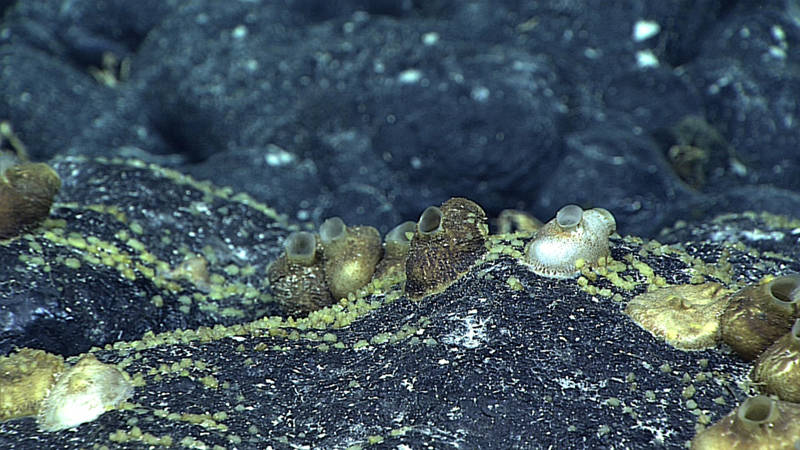
Large Styela sp tunicates interspersed with smaller yellow stoloniferous tunicates seen throughout most of the dive. Image courtesy of the NOAA Office of Ocean Exploration and Research, 2015 Hohonu Moana. Download larger version (jpg, 1.5 MB).

Large Styela sp tunicates interspersed with smaller yellow stoloniferous tunicates seen throughout most of the dive. Image courtesy of the NOAA Office of Ocean Exploration and Research, 2015 Hohonu Moana. Download larger version (jpg, 1.5 MB).
Dive 18: West Nihoa
Dive 18 was conducted on August 20 at a channel between Westpac Bank and Nihoa Island, which creates a constriction point for current flow. Video courtesy of the NOAA Office of Ocean Exploration and Research, 2015 Hohonu Moana. Download (mp4, 104.1 MB)
Dive 18 was conducted today at a channel between Westpac Bank and Nihoa Island, which creates a constriction point for current flow. The objective of the dive was to survey a completely unexplored area for corals and sponges, gathering information on whether high-density communities can be found in areas were the surrounding topography accelerates current flow. The dive started at 1,597 meters on an unsedimented, sloped, and heavily manganese-crusted surface consisting of pillows, boulders, and rubble. The substrate did not contain any sediment and was covered with high densities of large tunicates (Styela sp) as well as smaller unidentified stoloniferous tunicates. As the ROV moved up the slope of the ridge, the substrate continued to be covered with high densities of tunicates, which contained occasional pockets of debris consisting of barnacle plates. Several stalked sponges, live large sessile barnacles (Chirona sp), and chrysogorgid and primnoid corals were also observed, but only one bamboo coral. At 1,530 meters, there was a sudden increase in the density of chrysogorgid corals. As the ROV continued moving up the slope, it encountered very strong currents that impeded forward movement. As a result, the dive was aborted prematurely without reaching the planned endpoint. The ROV left the bottom at a depth of 1,515 meters after having covered a linear distance of 280 meters.